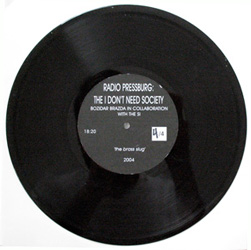Bozidar Brazda, Radio Pressburg: The I Don’t Need Society, 2004.
Born 1972 in Cambridge, Canada; lives in New York, New York
Bozidar Brazda designs his multimedia installations as performances to be “pulled apart” into individual elements, activating viewers’ participation as they navigate the spaces between his objects. Incorporating sculpture, painting, music, and video, Brazda’s aesthetically Postminimal, rough-hewn exhibitions center around partially autobiographical narratives that contextualize his tangible works not as evidence but as charmed arrangements which, through the stories embedded within them, impose a logic on the installation. These stories, conflating issues including past relationships with an unspecified Eastern European country, punk rock history, space travel, drug culture, and Communist or Socialist politics, are unified by a witty desire to represent “objective” history as art— something mutable, subjective, timeless, and poetic. While punk flyers and other remnant underground ephemera imply revolutionary politics, his installations also include off-kilter objects, such as loaves of bread, to undermine any perceived political stance with mystery and ambiguity. This obscurity negates potential nostalgia for the times and places Brazda’s works conjure, instead creating what he describes as a presenttense “meeting point” for viewers to reexperience those histories.
Brazda sometimes uses the gallery’s press release as a vehicle for narratives substantiating an exhibition’s actions and visuals. A story about an imprisoned journalist freed by Hegel-curious teen rebels served as the premise for The Journalist (2004) at New York’s Haswellediger & Co., for which flyers promoting a Danish punk band called Beret Cola were distributed as if for a concert. In lieu of a live show, Brazda passed out Beret Cola T-shirts and offered sandwiches on a handmade banquet-style table that also displayed two baguettes and a Persian rug draped around the stereo system serving as the band’s stand-in. By establishing a narrative of nonsensical connections in his exhibitions, Brazda creates a space in which the shattering of that narrative pushes it further toward absurdity.
Brazda’s 2008 Whitney Biennial contribution, Our Hour/Radioff (2008), is related to two previous audio installations, Radio Prussia (2004) and Radio Pressburg (2004). Fake radio programming plays in the gallery: spliced sequences of songs, interviews, recordings of friends and family, and scripted narration alternate with advertisements for fictive goods and services. Stacks of commercially packaged CDs of the recording provide a nonprecious, takeaway sculptural element. Like Radio Pressburg, which features punk music, spedup classic rock, and stories told by a narrator described as “the pan-morph and occasional time hobo,” Our Hour/ Radioff’s humor is built of outlandish moments at odds with each other. Brazda’s interest in what he calls “radio’s structure” operates on several levels, which, woven together, both actualize and destroy what he has presented to the viewer as art. TRINIE DALTON
Bozidar Brazda, Radio Pressburg: The I Don’t Need Society, 2004. Acetate record of performance, 10 in. (25.4 cm) diameter. Collection of the artist
























